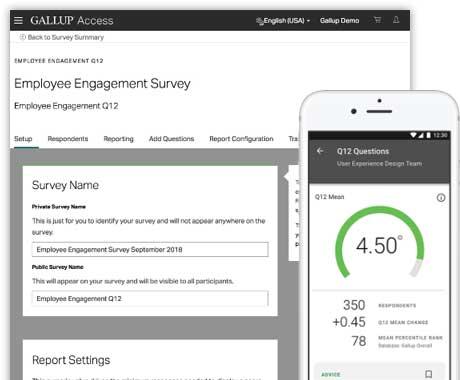Story Highlights
- Most employees are not engaged
- Managers create the conditions that promote employee engagement
- Coaching employees is key
Most employees are not engaged – only 23% worldwide and just 33% in the U.S. were engaged in 2021, according to Gallup’s State of the Global Workplace report. To figure out what's gone wrong with their engagement, leaders should study the behaviors of their highly engaged employees: What are they doing that the others are not?
Gallup, no stranger to the topic of engagement, finds there are several patterns of behavior unique to highly engaged employees, including:
- Despite challenges and barriers, the engaged don't often let problems become an excuse for inaction or destroy their ability to perform.
- They seek ways to operate at their best, which means they focus on their strengths and don't spend too much time trying to do what does not come naturally to them.
- They are intentional about their engagement. They have a plan and independently, proactively try to improve their engagement rather than expecting someone else to engage them.
- They take accountability for their performance instead of blaming others when things don't go as they want.
Are Employees the Only Ones Responsible for Engagement?
The natural question, therefore, is why not just teach workers to overcome barriers, focus on strengths, draft a plan and take accountability? Why encourage executive buy-in or make engagement part of a manager's job?
Employee engagement begins in the C-suite. Executives create the conditions for managers to foster engagement on their teams. Without leadership buy-in and support, managers will be fighting an uphill battle no matter how hard they strive to be engagement-creating coaches.
With leadership support, management must then do its part because Gallup finds that 70% of the variance in a team's engagement is related to management. Managers create the conditions that promote the behaviors of engaged employees (or just the opposite) with the relationships they establish. The manager is either an engagement-creating coach or an engagement-destroying boss, but both relationships affect employee behavior.
Coaches empower workers to take on challenges and use their strengths, which engages workers. Engaged workers don't need or want a boss, but they will seek out their manager's advice, assistance and advocacy to improve their performance. These empowering relationships nurture the behaviors of engagement -- "You help me do this so I can behave like that" -- that enable high performance.
The traditional boss, on the other hand, is transactional -- "You give me this, I behave like that" -- which can create learned helplessness, discouraging the discretional effort that engaged employees exhibit, and ultimately disengaged employees who don't own their own engagement.
As a result, they actually teach their employees to need constant managerial intervention because they can't overcome obstacles, plan, take accountability or operate with their strengths on their own. They have to be bossed, because that's the environment their managers have established.
Both kinds of relationships require a manager's close involvement, which is why managers have so much influence over engagement. But the kind of involvement is very different. The difference is especially noticeable in a key way: Coaches individualize, and bosses generalize.
The manager is either an engagement-creating coach or an engagement-destroying boss, but both relationships affect employee behavior.
All people have innate qualities that enable them to excel in particular ways. Matching those strengths to task or role can create extraordinary performance outcomes, and employees who work with their strengths tend to be more engaged than others.
Generalization blurs those differences. Bosses who generalize will have trouble capitalizing on strengths and may be unable to detect engagement problems.
Individualization allows managers to see workers' unique qualities as well as their engagement needs, which are different from worker to worker, day to day. That perspective helps them help workers articulate their own engagement needs. There's an exceptionally effective tactic for that, which managers can adapt for workplace engagement: the Socratic method.
Managers Must Ask Engagement-Oriented Questions
The Socratic method is a dialectic that poses questions to stimulate reflection and critical thinking. Coaches use the Socratic method -- though most probably don't label it as such -- to help workers think through challenges and solutions, analyze their performance and plan their approach to their work.
These questions are always influenced by the human element of engagement, the foundation of Gallup's Q12 engagement assessment. Employees perform at their best when these elements are fulfilled. Coaches incorporate these elements -- sometimes directly, sometimes obliquely, as the individual requires -- to connect workers to their own engagement.
| Q12 item measuring engagement | Employee need being measured | |||||||||||||||||||||||||||||||||||||||||||||||||||||||||||||||||||||||||||||||||||||||||||||||||||
|---|---|---|---|---|---|---|---|---|---|---|---|---|---|---|---|---|---|---|---|---|---|---|---|---|---|---|---|---|---|---|---|---|---|---|---|---|---|---|---|---|---|---|---|---|---|---|---|---|---|---|---|---|---|---|---|---|---|---|---|---|---|---|---|---|---|---|---|---|---|---|---|---|---|---|---|---|---|---|---|---|---|---|---|---|---|---|---|---|---|---|---|---|---|---|---|---|---|---|---|---|
| Basic Needs | ||||||||||||||||||||||||||||||||||||||||||||||||||||||||||||||||||||||||||||||||||||||||||||||||||||
| Q01. | I know what is expected of me at work. | Focus me | ||||||||||||||||||||||||||||||||||||||||||||||||||||||||||||||||||||||||||||||||||||||||||||||||||
| Q02. | I have the materials and equipment I need to do my work right. | Free me from unnecessary stress | ||||||||||||||||||||||||||||||||||||||||||||||||||||||||||||||||||||||||||||||||||||||||||||||||||
| Individual | ||||||||||||||||||||||||||||||||||||||||||||||||||||||||||||||||||||||||||||||||||||||||||||||||||||
| Q03. | At work, I have the opportunity to do what I do best every day. | Know me | ||||||||||||||||||||||||||||||||||||||||||||||||||||||||||||||||||||||||||||||||||||||||||||||||||
| Q04. | In the last seven days, I have received recognition or praise for doing good work. | Help me see my value | ||||||||||||||||||||||||||||||||||||||||||||||||||||||||||||||||||||||||||||||||||||||||||||||||||
| Q05. | My supervisor, or someone at work, seems to care about me as a person. | Care about me | ||||||||||||||||||||||||||||||||||||||||||||||||||||||||||||||||||||||||||||||||||||||||||||||||||
| Q06. | There is someone at work who encourages my development. | Help me grow | ||||||||||||||||||||||||||||||||||||||||||||||||||||||||||||||||||||||||||||||||||||||||||||||||||
| Teamwork | ||||||||||||||||||||||||||||||||||||||||||||||||||||||||||||||||||||||||||||||||||||||||||||||||||||
| Q07. | At work, my opinions seem to count. | Hear me | ||||||||||||||||||||||||||||||||||||||||||||||||||||||||||||||||||||||||||||||||||||||||||||||||||
| Q08. | The mission or purpose of my company makes me feel my job is important. | Help me see my importance | ||||||||||||||||||||||||||||||||||||||||||||||||||||||||||||||||||||||||||||||||||||||||||||||||||
| Q09. | My associates or fellow employees are committed to doing quality work. | Help me feel proud | ||||||||||||||||||||||||||||||||||||||||||||||||||||||||||||||||||||||||||||||||||||||||||||||||||
| Q10. | I have a best friend at work. | Help me build trust | ||||||||||||||||||||||||||||||||||||||||||||||||||||||||||||||||||||||||||||||||||||||||||||||||||
| Growth | ||||||||||||||||||||||||||||||||||||||||||||||||||||||||||||||||||||||||||||||||||||||||||||||||||||
| Q11. | In the last six months, someone at work has talked to me about my progress. | Help me review my contribution | ||||||||||||||||||||||||||||||||||||||||||||||||||||||||||||||||||||||||||||||||||||||||||||||||||
| Q12. | This last year, I have had opportunities at work to learn and grow. | Challenge me | ||||||||||||||||||||||||||||||||||||||||||||||||||||||||||||||||||||||||||||||||||||||||||||||||||
| Copyright 1993-1998, 2019 Gallup, Inc. All rights reserved. | ||||||||||||||||||||||||||||||||||||||||||||||||||||||||||||||||||||||||||||||||||||||||||||||||||||
| Gallup | ||||||||||||||||||||||||||||||||||||||||||||||||||||||||||||||||||||||||||||||||||||||||||||||||||||
For instance, there may be any number of reasons a worker is struggling to complete a project. A boss would simply give a deadline, but a coach would also ask questions:
"This report has been on your desk for a while now. Are you having trouble getting the information you need to complete it? Do you know what's expected of you? Does it seem so low-priority you can afford to put it off? Do you need help?"
Those are process-oriented questions, but they all connect to engagement elements as well: access to necessary materials, having clear expectations, connecting tasks to the organization's mission or purpose, proof that the manager cares.
Questions like those give managers perspective on each worker's employee experience and facilitate individualization and advocacy. Employees' answers direct them to align their day-to-day work with their engagement. Just having the conversation empowers workers to overcome obstacles, focus on their strengths, take accountability and proactively improve their engagement.
Those, of course, are the behaviors associated with highly engaged workers. They don't surface by accident. Those behaviors are a result of environmental conditions constructed and maintained by managers.
That's why those behaviors can't be taught to or demanded from employees. Those behaviors are a spontaneous outcome of relationships that managers must carefully tend.
So, while it's instructive to look at the behaviors of highly engaged workers to understand what they do that others don't, the lesson to learn is not to be found just with the employees. It's also to be found with the manager.
As of now, only 20% of workers worldwide have managers who enable the behaviors of engagement. That doesn't give leaders a very large group to learn from -- but it does show that it's time to start learning.
Learn more about what it means to own your own engagement:
- Make engagement central to your business strategy and explore Gallup's employee engagement offerings.
- An engaged workplace is only 12 questions away with Gallup's Q12 survey. Request a demo and see how your workplace could change.
- Discover how to improve employee engagement at your organization.



